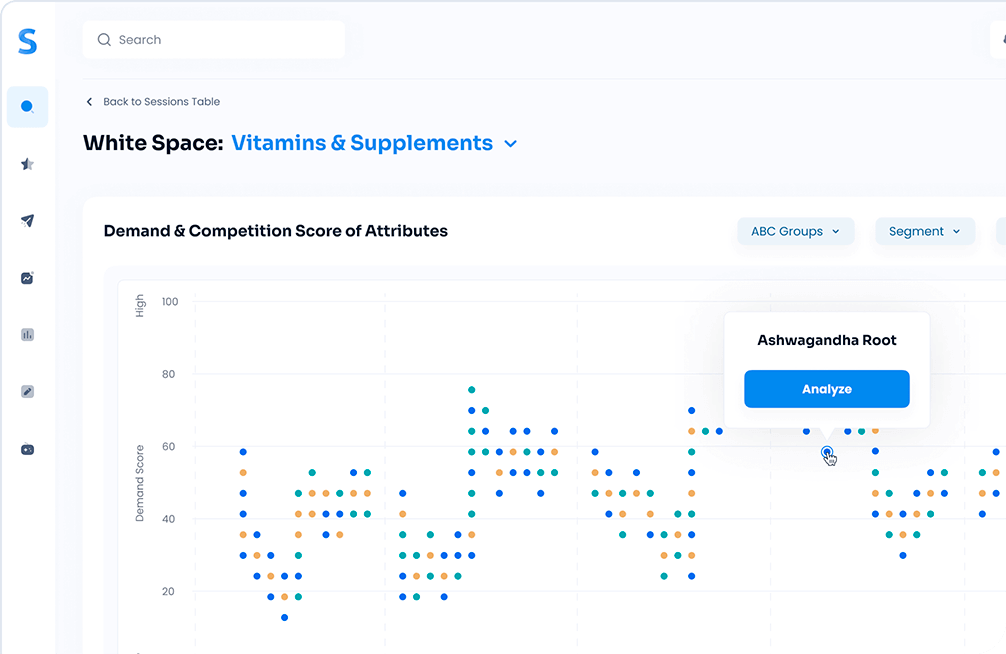Artificial intelligence (AI) is changing the world right in front of our eyes. ChatGPT, the popular AI chatbot, is becoming the go-to tool for all types of research. From finding simple explanations of scientific concepts to writing thoughtful fiction, the chatbot by OpenAI has surpassed expectations. So can it also help with product research?
Whether you’re an entrepreneur looking to sell a product the market craves or an already established business branching out with something new, undertaking thorough product research is typically the first step. It involves gathering data from multiple sources, identifying existing competitors, and determining profitability.
Since the purpose is research, a tool like ChatGPT should be useful, right? Well, it can be beneficial but it has limitations.
In this article, we’ll explore how ChatGPT will affect product research, how researchers can use it to their advantage, and what it can and cannot do.
Key takeaways
- ChatGPT can assist in product research by facilitating brainstorming, data gathering, competitor analysis, trend identification, and report writing.
- Limitations of ChatGPT include the need for context, potential inaccuracies in responses, limited data access, and a lack of human-like comprehension of emotions.
- Researchers should verify and cross-reference the data obtained from ChatGPT for authenticity and accuracy before making decisions.
- ChatGPT can save time and provide valuable insights but cannot replace human expertise and the need for robust research methodologies.
- Dedicated product research tools like Simporter offer more accurate and specialized solutions for ideation and product launches.
Understanding GPT and ChatGPT
ChatGPT is the name of the chatbot or application supported by a Generative Pre-Trained Transformer (GPT).
GPTs are language models that produce human-like responses to prompts. These models are trained through deep neural networks to identify and learn the link between words and sentences. They can perform various tasks, such as answering questions, writing essays, and even translating text from one language to another.
ChatGPT is simply the user interface that lets people interact with GPT.
So How Can ChatGPT Help with Product Research?
ChatGPT combines the capabilities of a search engine, editor, and virtual assistant. With the introduction of GPT4, the program has become extremely good at producing human-like text.
As it’s trained on abundant data from the internet, it can be quite useful for product research. Here’s how product researchers can take advantage of ChatGPT.
Brainstorming Ideas

During the ideation stage of product research, you’ll need to develop ideas for potential products, their design, features, or benefits. A chatbot like ChatGPT, which is empowered with information, can be a great partner for brainstorming.
It would be no different than sharing your ideas or thoughts with a colleague, who then contributes their two cents, except ChatGPT is not as opinionated as humans. Nevertheless, it can help researchers quickly determine whether an idea has legs.
Gathering Data
The most critical part of product research is collecting and analyzing data to determine which products are trending or which ones the market lacks. ChatGPT, although a chatbot, can traverse the internet to gather publicly-available data, i.e., market reports, sales reports, surveys, etc.
Normally, this process would take considerable time if you were to research the data on a search engine. However, with ChatGPT, you can save time and get relevant data rather quickly.

That said, ChatGPT may only be able to pull public data up to September 2021, which may limit the scope of your research, although, with GPT4, OpenAI has also introduced a web-browsing version of ChatGPT that connects to the internet.
It works similarly to a search engine, and unlike normal ChatGPT responses, it shows where the response is taken from. Using this feature for data research can ensure that your data is from a trustworthy source and up-to-date.
Competitor Analysis
Similar to collecting data, ChatGPT can also be instrumental in identifying and analyzing potential competitors in the market. Competitor analysis is a key component of comprehensive product research. When you’ve zeroed in on a category or product, ChatGPT can be used to find the relevant competition.
For instance, you want to launch a clean and organic lip color line. To find the top brands already selling a similar product, you can prompt ChatGPT something like ‘What are the top clean beauty brands in North America?’
It simplifies the process and lists competitors based on the available results online. It can be the starting point to further investigate the companies by visiting their websites, reading customer reviews, and analyzing their sales data (if they made it public).
Trend Analysis

If you want to cash in on a trend, you have to quickly identify it and get the product on the market as soon as possible. Although not always sustainable, trends can provide the impetus to get the product into the market. And with trends, time is of the essence.
ChatGPT may be helpful in identifying the latest online trends, particularly on social media. However, there are limitations to its access to social media. Therefore, the results may not be as profound as you’d like. Nevertheless, it’s a good starting point for finding the current ‘viral’ product.
Write the Product Research Report
ChatGPT is best at writing. Researching and gathering data is one thing; presenting it in a digestible, easy-to-read format is another. And that’s where ChatGPT shines. Product researchers can use the tool to turn their findings into a well-written, professional-sounding proposal.
You can get the chatbot to write the text by providing sample data in the prompt. Alternatively, you can write the text yourself and have the tool rewrite it for you in the language, format, and tone you want.
So whether you use it for research or not, it can definitely help turn the findings into concise, eloquent text that can be used to pitch ideas to investors or senior management.
ChatGPT Is Great, But It Can’t Do It All

A few months into its launch, ChatGPT garnered over 100 million users. It’s not a fad, as it has become the tool of choice for research and writing in virtually every industry. From academic essays to clever captions for social media posts, users are leveraging the power of AI language generation to do things fasters and, sometimes, better.
We can all agree that it’s an incredibly useful tool for research and writing. However, there’s a lot that it can’t do yet. There are limitations to what it can access, what it can produce, and what you can use it for.
In the context of product research, the limitations of ChatGPT are even more consequential. You need authentic, reliable, and unbiased results for your research. Unfortunately, that may not always be the case with ChatGPT, as the chatbot is known for producing inaccurate or biased responses.
Let’s dive more into what makes it not so great for product research.
Requires Context, A Lot of It

ChatGPT requires context for better, more accurate results. It’s the responsibility of the prompter to provide that context in their query, and sometimes it’s not so easy to do that. Without proper context, the response is often generic, which isn’t of much help during a process as scrupulous as product research.
While ChatGPT can quickly give answers, the accuracy and effectiveness of the responses ultimately depend on how well you phrase the question. This is why many marketers and researchers spend time prompting the tool and refining their questions to get what they want.
Furthermore, ChatGPT also lacks a comprehensive understanding of context. For instance, it may not fully grasp subtle sarcasm.
You need to be very specific with the prompts to get your hands on useful data. That may take some playing around and experimenting to learn. The more context you provide with your query, the more relevant answers you might get. This, of course, requires time, which many researchers may not have.
Accuracy of Responses Is Doubtful
Yes, it sounds like you’re talking to an actual human, but ChatGPT can also lie like humans. It’s not the fault of the tool but the data it has been trained on. As a lot of information and data available on the Internet is inaccurate, ChatGPT’s synthesis of such data results in similarly untrue responses.
AI chatbots like ChatGPT draw on a huge pool of websites, including Wikipedia and Reddit, to put together responses to a question. As they are trained to identify patterns of words, they can generate grammatically correct, human-sounding sentences. However, they cannot verify the authenticity or accuracy of their words, which can result in lies.

For successful product research, it’s imperative to rely on authentic information. If you can’t fully trust the data the tool relies on, you can’t use its findings to make decisions.
OpenAI and other tech companies heavily invested in tools such as ChatGPT are working on fixing this issue and incorporating fact-checking mechanisms to increase the authenticity and accuracy of their responses. However, for the time being, ChatGPT’s responses are subject to inaccuracy or bias, which makes it a hard sell for researchers looking for authentic data.
Limitations of Data Access
GPT4, the most advanced model by OpenAI, can only access public data. For deeper analysis, such as in the case of product and market research, you may need more data. For instance, you may need to manually download earning reports from industry leaders and dissect the data to find useful information.
Also, although an impressive human feat in its own right, ChatGPT doesn’t possess all the knowledge humans have. So even with access to online public data, articles, and books, there may be some things ChatGPT may not be able to comprehend as well as humans. Emotions, for instance, cannot be interpreted by chatbots as well as humans.
And in product research, analyzing consumer emotions is often an important job. Assessing which products or features evoke which emotions are a critical part of the process, and humans may be able to analyze other people’s reactions better.
Takeaway

Product research can benefit greatly from the use of a tool like ChatGPT. It can access open internet (with the use of the web-browsing version of ChatGPT) and turn text pages into an easy-to-understand summary. Although presented as a chatbot, it’s a powerful research tool researchers can harness to find the information they seek while saving time.
So will it change product research entirely? Not really! Some limitations prevent it from being an all-encompassing research tool, especially in the case of product research. That’s not to say that product researchers shouldn’t consider using it. They should use it as a jump-off point to discuss and review ideas and find more product information.
However, more specific and robust tools must be used for comprehensive product research. The inaccuracy and biases of the chatbot can result in information that isn’t fully correct, which beats the very purpose of product research.
While it can help with the research process, it can’t entirely replace human expertise and judgment. The insights can help researchers make decisions, but it’s upon them to verify the authenticity and use their expertise to analyze the provided information.
Simporter is an AI-powered tool designed to help product researchers with the ideation and launch of their next promising product. Unlike AI chatbots, this tool is dedicated to this very purpose, providing an interface that makes it easy to find answers to your questions. Using proprietary AI models, Simporter guarantees the highest accuracy data.









